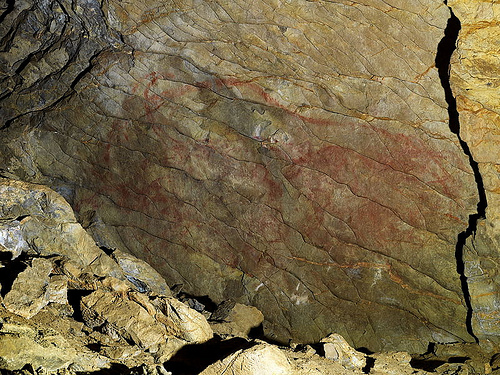
A team of scientists from the Universities of Cantabria and Burgos in Spain and Toulouse in France have dated prehistoric wall paintings in the Altxerri cave system in the Gipuzkoa province of northern Spain to about 39,000 years BPE, making them among the earliest known cave paintings produced by humans in Europe.
It was in 2011 when Cantabria University members Aitor Ruiz and César González began to explore the upper gallery of the cave, designated Altxerri B, with the objective of coming up with some reliable dates for the less-explored wall paintings in this part of the cave system. These paintings appeared to have been done independently of other paintings found in a lower gallery, paintings already with known dates that fell within the 29,000 – 35,000 BPE range. The paintings in this upper gallery were figurative representations of a bison (the most common element among the Altxerri cave system paintings) a feline, a possible animal’s head, a bear and two groups of three finger marks, as well as other motifs. Ruiz and González also employed the help of Diego Garate, a specialist in Upper Paleolithic cave art from the University of Toulouse, to help them place and interpret the paintings and their findings within the context of current knowledge about Paleolithic art in Europe.
“Archaeological, geological and stylistic evidence, together with radiometric dates, suggest an Aurignacian chronology for this art,” reported the investigators. “The ensemble in Altxerri B can therefore be added to the small but growing number of sites dated in this period, corroborating the hypothesis of more complex and varied figurative art than had been supposed in the early Upper Palaeolithic.”*
________________________________________________________________________________________________________________________
Wall painting in the Altxerri cave depicting bison. GipuzkoaKultura, Wikimedia Commons
_______________________________________________________________________________________________________________________
The Aurignacian culture is an archaeological culture of the Upper Palaeolithic (50,000 to 10,000 years ago), common to Europe and southwest Asia. It existed from ca. 45,000 to 35,000 years ago. Although the Altxerri cave system is somewhat less known to the public than other cave systems, such as the Altamira, also in Spain, and Chauvet in France, they are known to feature galleries of prehistoric paintings dated back to similar periods of time, and are still under investigation. They were first discovered in 1956 but archaeologists didn’t begin serious examination and study of the figures and markings in the caves until the early 1960’s. The Altxerri is now listed as a UNESCO World Heritage Site.
Who were the humans who created these paintings? Were they modern humans or Neanderthals? Thus far there is no evidence linking the paintings to any particular human species.
The detailed report of the findings have been published in the Journal of Human Evolution as Not only Chauvet: Dating Aurignacian rock art in Altxerri B Cave (northern Spain).
____________________________
* http://www.sciencedirect.com/science/article/pii/S0047248413001851#bib1
______________________________________________________________________________________________________________________
Read about the most fascinating discoveries with a premium subscription to Popular Archaeology Magazine. Find out what Popular Archaeology Magazine is all about. AND MORE:
 Popular Archaeology’s annual Discovery edition is a selection of the best stories published in Popular Archaeology Magazine in past issues, with an emphasis on some of the most significant, groundbreaking, or fascinating discoveries in the fields of archaeology and paleoanthropology and related fields. At least some of the articles have been updated or revised specifically for the Discovery edition. We can confidently say that there is no other single issue of an archaeology-related magazine, paper print or online, that contains as much major feature article content as this one. The latest issue, volume 2, has just been released. Go to the Discovery edition page for more information.
Popular Archaeology’s annual Discovery edition is a selection of the best stories published in Popular Archaeology Magazine in past issues, with an emphasis on some of the most significant, groundbreaking, or fascinating discoveries in the fields of archaeology and paleoanthropology and related fields. At least some of the articles have been updated or revised specifically for the Discovery edition. We can confidently say that there is no other single issue of an archaeology-related magazine, paper print or online, that contains as much major feature article content as this one. The latest issue, volume 2, has just been released. Go to the Discovery edition page for more information.
Subscription Price: A very affordable $5.75 for those who are not already premium subscribers of Popular Archaeology Magazine (It is FREE for premium subscribers to Popular Archaeology). Premium subscribers should email [email protected] and request the special coupon code. Or, for the e-Book version, it can be purchased for only $3.99 at Amazon.com.






